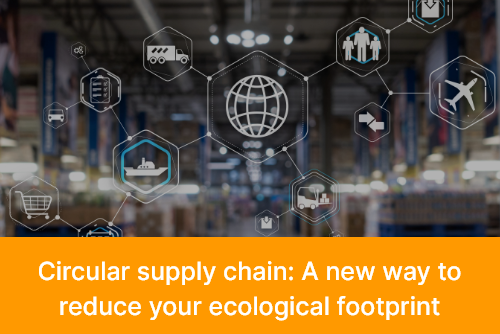Circular Supply Chain: A New Way to Reduce Your Ecological Footprint
Deepak Bora
on
March 7, 2024

Imagine your supply chain as a giant orchestra and your products as symphonies. The right notes always resonate and stay with listeners, as does the right timing. However, musicians compose songs and tunes and then keep playing them — thus reusing them, but your supply chain does not follow the sustainable approach of remanufacturing and reusing.
Imagine a world where production does not end with wastage; instead, it becomes a prelude to another historic symphony or product. Today, businesses have understood the benefits of sustainable development and entered a circular economy, where products are reborn, and the old, linear practice of take-make-dispose is put on hold.
When the circular economy came to supply chain management , a new term was coined: “circular supply chain.” It has emerged as a promising solution to resource scarcity, environmental degradation, and waste disposal issues. It is more than the latest buzzword; it’s a necessity, a watershed moment that’s shaking up industries and giving Mother Earth a much-needed breather.
What is a Circular Supply Chain?
A circular supply chain is an approach that businesses use to minimize waste and maximize resource utilization. It puts life back into the linear supply chain model, where you produce, consume, and then discard as waste. Contrastingly, the circular approach, as the name suggests, is a closed-loop system. Products are designed to be recycled, refurbished, or repurposed, creating a continuous cycle that minimizes waste and maximizes resource efficiency. In a circular supply chain, recyclability is a critical determining factor, besides designing for longevity and durability. Once used, products are either repaired, refurbished, or recycled to create new products or materials.
Why Circular Supply Chain?
There are many answers to that question. However, it is interesting which answers businesses like to choose and make their objective. A circular economy tends to keep resources in use for longer, and that reduces costs. Also, the increasing amount of waste generated due to the linear model has resulted in an increase in resource depletion, created an ecological mess, and caused ecosystem and economic suffering.
The analogy of our planet drowning in a sea of discarded goods is truer today than ever, and the circular supply chain is a response to this environmental SOS, offering a lifeline to a planet gasping for breath.
Below are some crucial points that make a case for a circular supply chain:
-
Conserves resources
This helps save finite resources such as raw materials, energy, and water by reducing the need for extraction and processing. -
Reduces environmental impact
The circular way minimizes waste generation and promotes resource efficiency, reducing businesses’ ecological footprint. -
Benefits the bottom line
Reduced production costs, creation of a new revenue stream, and enhanced brand reputation are a few ways in which circular supply chains provide economic benefits. -
Rise in demand
Today, consumers demand more sustainable products, and they understand how important it is to promote and consume environmentally friendly products. A circular supply chain can help businesses meet this growing demand. -
Regulatory Compliance
Governments are implementing regulations to promote circularity, and businesses that adopt a circular supply chain are better positioned to comply with these regulations.
Benefits of Circular Supply Chain
-
Environmental governance
The main aim of the circular process is to extend the life of the materials and make products that can be remanufactured, recycled, and repaired. Doing so limits a company’s ecological footprint, which is a win-win for all stakeholders (consumers, companies, and nature). A small footprint means less waste, fewer landfills, and less pollution. -
Resource efficiency
One of the most critical aspects for any business is to reduce production costs, which is achieved easily by increasing the efficiency of resource use. The expanded lifespan of resources reduces the usage of novel resources and results in saving some extra cash. -
Cost savings
The interplay between cost and revenue is a critical symphonic composition for a business. Implementing circular logistics and supply chain is budget friendly and ensures savings as well. With the linear approach, once the material or products have been used, there is no way to bring them back into operation, which increases cost. Contrastingly, in a circular approach, recycling and easy disassembly often result in low manufacturing costs. -
Loyal customers
Customers usually don’t just buy products. They buy values. They want to be associated with brands that value their values and work towards a better future. A circular supply chain or circular economy resonates with the customer’s eco-conscious approach, allowing customers to bond with businesses.
Finally, what it all implies
The circular supply chain isn’t a mere trend; it’s a necessity, a paradigm shift committed to a sustainable, resilient, and economically viable future. It offers a transformative approach to supply chain management that is environmentally sustainable and financially beneficial. A circular supply chain or logistics is a smart business strategy for a future where resources are increasingly scarce and environmental concerns are paramount. Know more about supply chain planning solutions with Avercast.
- Category: Blogs


